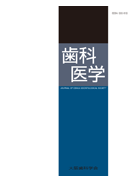Volume 65, Issue 3_4
Displaying 1-32 of 32 articles from this issue
- |<
- <
- 1
- >
- >|
-
Article type: Article
2002 Volume 65 Issue 3_4 Pages 217-226
Published: December 25, 2002
Released on J-STAGE: April 24, 2017
Download PDF (1150K) -
Article type: Article
2002 Volume 65 Issue 3_4 Pages 227-234
Published: December 25, 2002
Released on J-STAGE: April 24, 2017
Download PDF (795K) -
Article type: Article
2002 Volume 65 Issue 3_4 Pages 235-240
Published: December 25, 2002
Released on J-STAGE: April 24, 2017
Download PDF (665K) -
Article type: Article
2002 Volume 65 Issue 3_4 Pages 241-247
Published: December 25, 2002
Released on J-STAGE: April 24, 2017
Download PDF (793K) -
Article type: Article
2002 Volume 65 Issue 3_4 Pages 248-254
Published: December 25, 2002
Released on J-STAGE: April 24, 2017
Download PDF (741K) -
Article type: Article
2002 Volume 65 Issue 3_4 Pages 255-265
Published: December 25, 2002
Released on J-STAGE: April 24, 2017
Download PDF (1381K) -
Article type: Article
2002 Volume 65 Issue 3_4 Pages 266-274
Published: December 25, 2002
Released on J-STAGE: April 24, 2017
Download PDF (864K)
-
Article type: Article
2002 Volume 65 Issue 3_4 Pages 275-276
Published: December 25, 2002
Released on J-STAGE: April 24, 2017
Download PDF (297K) -
Article type: Article
2002 Volume 65 Issue 3_4 Pages 276-
Published: December 25, 2002
Released on J-STAGE: April 24, 2017
Download PDF (180K) -
Article type: Article
2002 Volume 65 Issue 3_4 Pages 277-
Published: December 25, 2002
Released on J-STAGE: April 24, 2017
Download PDF (168K) -
Article type: Article
2002 Volume 65 Issue 3_4 Pages 278-
Published: December 25, 2002
Released on J-STAGE: April 24, 2017
Download PDF (190K) -
Article type: Article
2002 Volume 65 Issue 3_4 Pages 279-
Published: December 25, 2002
Released on J-STAGE: April 24, 2017
Download PDF (161K) -
Article type: Article
2002 Volume 65 Issue 3_4 Pages 280-
Published: December 25, 2002
Released on J-STAGE: April 24, 2017
Download PDF (164K) -
Article type: Article
2002 Volume 65 Issue 3_4 Pages 281-
Published: December 25, 2002
Released on J-STAGE: April 24, 2017
Download PDF (156K) -
Article type: Article
2002 Volume 65 Issue 3_4 Pages 282-
Published: December 25, 2002
Released on J-STAGE: April 24, 2017
Download PDF (168K) -
Article type: Article
2002 Volume 65 Issue 3_4 Pages 282-283
Published: December 25, 2002
Released on J-STAGE: April 24, 2017
Download PDF (296K) -
Article type: Article
2002 Volume 65 Issue 3_4 Pages 283-284
Published: December 25, 2002
Released on J-STAGE: April 24, 2017
Download PDF (297K) -
Article type: Article
2002 Volume 65 Issue 3_4 Pages 284-285
Published: December 25, 2002
Released on J-STAGE: April 24, 2017
Download PDF (292K) -
Article type: Article
2002 Volume 65 Issue 3_4 Pages 285-286
Published: December 25, 2002
Released on J-STAGE: April 24, 2017
Download PDF (289K) -
Article type: Article
2002 Volume 65 Issue 3_4 Pages 286-287
Published: December 25, 2002
Released on J-STAGE: April 24, 2017
Download PDF (292K) -
Article type: Article
2002 Volume 65 Issue 3_4 Pages 287-288
Published: December 25, 2002
Released on J-STAGE: April 24, 2017
Download PDF (296K) -
Article type: Article
2002 Volume 65 Issue 3_4 Pages 288-289
Published: December 25, 2002
Released on J-STAGE: April 24, 2017
Download PDF (300K) -
Article type: Article
2002 Volume 65 Issue 3_4 Pages 289-290
Published: December 25, 2002
Released on J-STAGE: April 24, 2017
Download PDF (279K)
-
Article type: Article
2002 Volume 65 Issue 3_4 Pages A1-A2
Published: December 25, 2002
Released on J-STAGE: April 24, 2017
Download PDF (254K) -
Article type: Article
2002 Volume 65 Issue 3_4 Pages A2-A3
Published: December 25, 2002
Released on J-STAGE: April 24, 2017
Download PDF (226K) -
Article type: Article
2002 Volume 65 Issue 3_4 Pages A4-A5
Published: December 25, 2002
Released on J-STAGE: April 24, 2017
Download PDF (238K) -
Article type: Article
2002 Volume 65 Issue 3_4 Pages A5-A6
Published: December 25, 2002
Released on J-STAGE: April 24, 2017
Download PDF (244K) -
Article type: Article
2002 Volume 65 Issue 3_4 Pages A7-A8
Published: December 25, 2002
Released on J-STAGE: April 24, 2017
Download PDF (242K) -
Article type: Article
2002 Volume 65 Issue 3_4 Pages A8-A9
Published: December 25, 2002
Released on J-STAGE: April 24, 2017
Download PDF (218K) -
Article type: Article
2002 Volume 65 Issue 3_4 Pages A10-
Published: December 25, 2002
Released on J-STAGE: April 24, 2017
Download PDF (147K) -
Article type: Article
2002 Volume 65 Issue 3_4 Pages A11-A12
Published: December 25, 2002
Released on J-STAGE: April 24, 2017
Download PDF (281K) -
Article type: Article
2002 Volume 65 Issue 3_4 Pages A13-A14
Published: December 25, 2002
Released on J-STAGE: April 24, 2017
Download PDF (263K)
- |<
- <
- 1
- >
- >|
